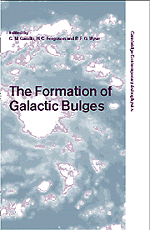Preface
Published online by Cambridge University Press: 10 November 2010
Summary
The innermost, denser regions of galaxies, i.e., the ‘bulges’, are a fundamental component of galaxies whose properties define the entire Hubble sequence. Understanding the origin of bulges is thus a required step toward understanding how such a sequence has come to place, i.e., toward deciphering how stars and galaxies condensed from the diffuse material in space into the structure that we observe today. Several decades of exploration of the Milky Way and Local Group bulges, and of nearby bulges external to the Local Group, have slowly built the orthodox view that bulges as a family should be reasonably old isotropic rotators with near-solar mean chemical abundances (although with a very wide abundance distribution function), i.e., nothing more than low-luminosity ellipticals. However, some major breakthroughs in the last few years concerning bulges in the local and early universe suggest that the time is ripe to perhaps reconsider this orthodoxy. The new picture that emerges from the most recent Hubble Space Telescope (HST) and 10m-class ground-based telescopes studies challenges the canonical beliefs about what bulges really are, how and when they form, and about the physical mechanisms that are important in determining their fundamental properties. Basic, and yet fundamental questions still need an answer: (i) Are bulges a one-parameter or a multi-parameter family? What are the average properties of bulges in terms of stellar populations and dynamics? What are the deviations from these averages?
- Type
- Chapter
- Information
- The Formation of Galactic Bulges , pp. xi - xiiiPublisher: Cambridge University PressPrint publication year: 2000



